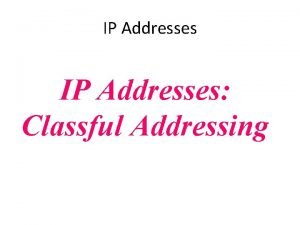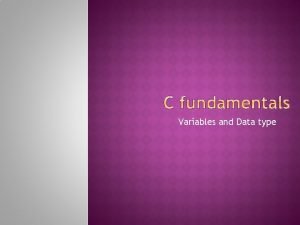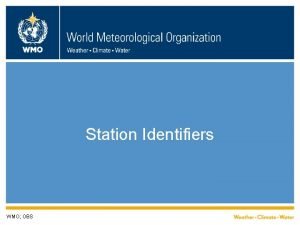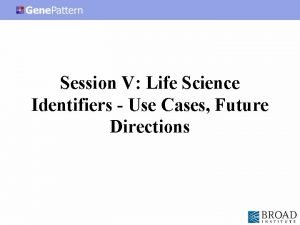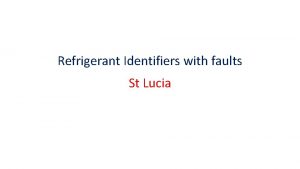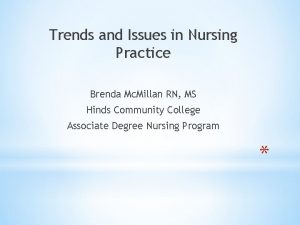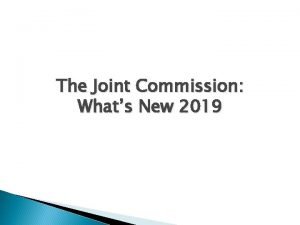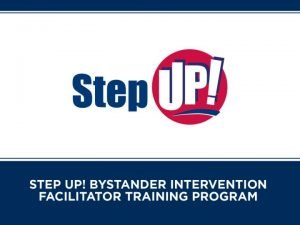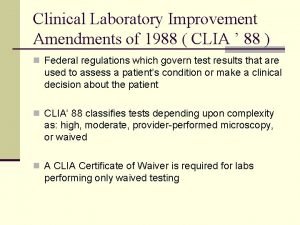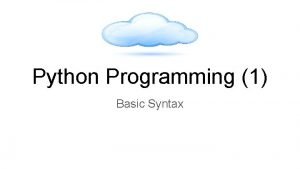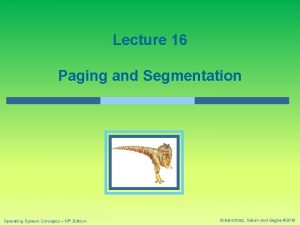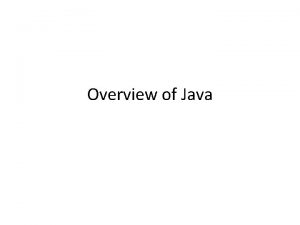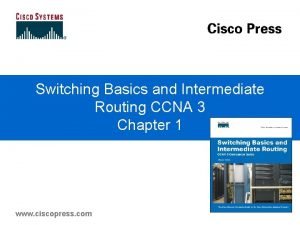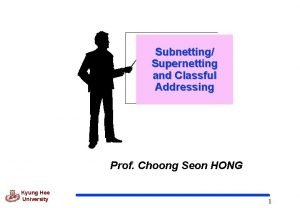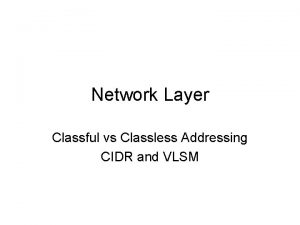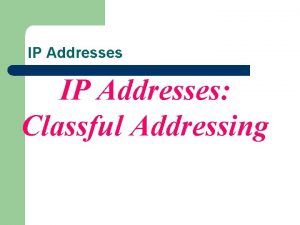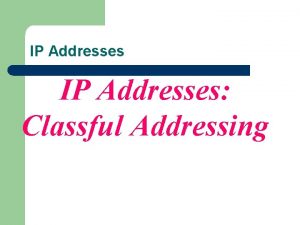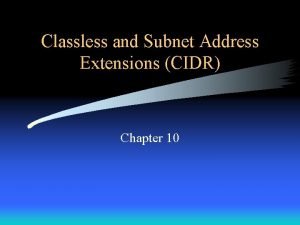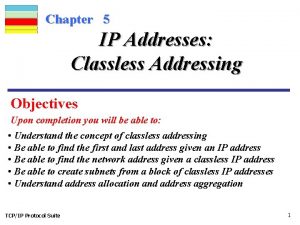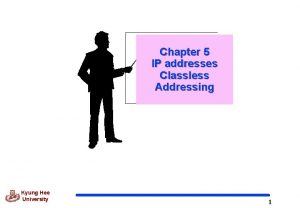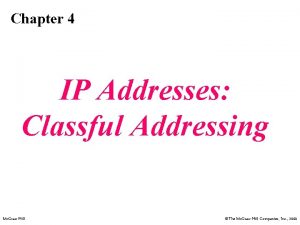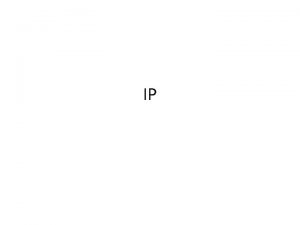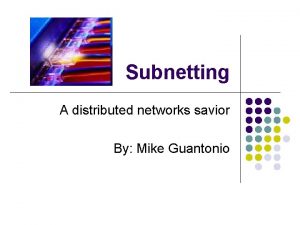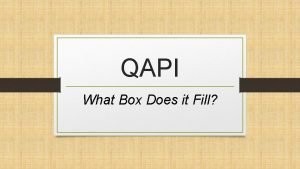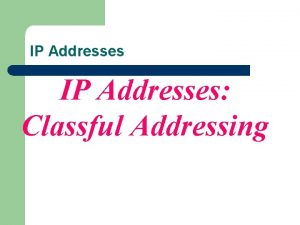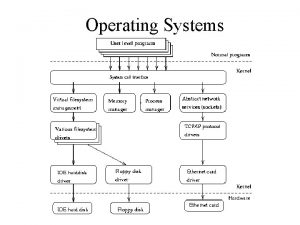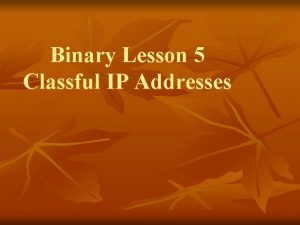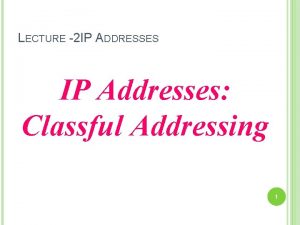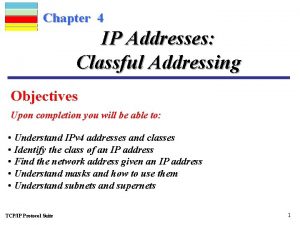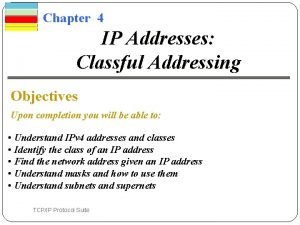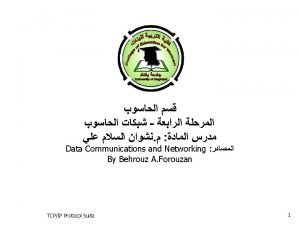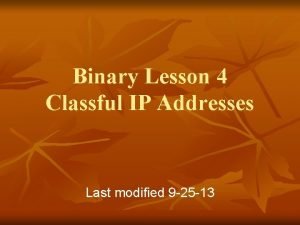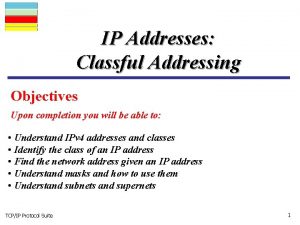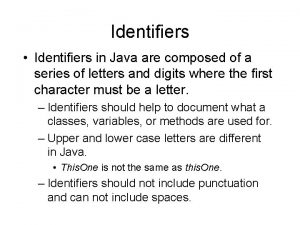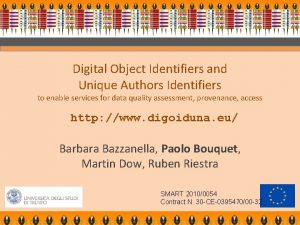Classful Internet Addresses Chapter 4 Universal Identifiers For




























- Slides: 28

Classful Internet Addresses Chapter 4

Universal Identifiers For our TCP/IP internet, we need an addressing scheme n n To hide the physical network details To give the appearance of one, big network Universal Communication Service n n Allows any host to communicate with any other Need a globally accepted method of identifying attached computers

Host identifiers classified as: n n n Name: identify what an object is Address: identify where it is Route: Tell how to get there Refer to successively lower levels of host identifiers In general, n n People prefer pronounceable names Machines do better with compact representation Standardized to compact, binary address

Original Classful Scheme Each host is assigned a 32 -bit integer n n Cleverly chosen to make routing efficient Encode info about the network of the host Prefix identifies a network Each address is a (netid, hostid) pair n n Each address is self-identifying Quickly extract netid or host id

0 1 2 3 4 Class A 0 … 8 netid Class B 1 0 Class C 1 1 0 16 24 31 hostid netid hostid Class D 1 1 1 0 multicast address Class E 1 1 reserved for future use

What does an address specify? Said “Address identifies a host” n Like the Hertz commercial (…not exactly!) Consider a router connecting 2 networks n n IP address has a netid and hostid Can’t have single IP address (must have 2) Multi-homed hosts n Computer with 2 or more connections IP ADDRESSES SPECIFY A CONNECTION TO A NETWORK (not an individual computer)

Network & Broadcast Addressing Encoded addresses make routing efficient Also allows address to refer to networks as well as hosts n Hostid 0 refers to the network itself Directed broadcast n Hostid of all 1’s (to all hosts of final router) Due to error in Unix release, hostid of all 0’s is used, too Has some valid netid n Powerful Single packet from source (traveling the internet) Delivered to all hosts on the destination network

Limited broadcast n n Broadcast aimed at the local network Independent of the assigned IP address Consists of 32 1’s Host can use this as part of the startup Before it learns its IP address Before it learns the IP address for the local network Once local network IP address is learned, directed broadcast should be used

All-0 s Address of thirty-two 0 bits is reserved n n Used when host needs to communicate But does not yet know its IP address Temporarily at startup Host will have to obtain its IP address n n Send a datagram via limited broadcast Use address 0 to identify itself Receiver understands host does not yet know its IP address Uses a special method to send a reply

Extension to Classful Addressing Need unique network prefix for each network In 1980’s, LANs caught on n Address space would soon be exhausted Developed subnet addressing n Multiple physical networks share a prefix In 1990’s, came up with supernetting n n Classless addressing scheme Allows prefix/suffix boundary to be arbitrary Wait until chapter 9…. .

Multicast Addressing Unicast: packet to single computer Broadcast: packet to all computers on the network Multicast: n n n Packet delivered to a subset of hosts Class D of original scheme is reserved for this Wait until chapter 16….

Addressing Weaknesses Addresses refer to network connection n n If host computer moves, need new IP address Bad for laptops! Chapter 18 covers mobility problems Chapter 22 covers DHCP Growing pains n n If a Class C network gets more than 255 hosts, must change to Class B address No way to do gracefully

Causes problems in routing n n A host may have two connections Path taken by packets to same host depends on the address used Sometimes confusing to humans Packets to same host will behave differently Knowing only one IP address for the destination may not be enough


Dotted Quad 32 -bit IP address: 100000001010 00000010 00011110 is written as: 128. 10. 2. 30 With classful addressing: Class Lowest Address Highest Address A 1. 0. 0. 0 127. 0. 0. 0 B 128. 0. 0. 0 191. 255. 0. 0 C 192. 0. 0. 0 223. 255. 0 D 224. 0. 0. 0 239. 255 E 240. 0 255. 254

Not all possible addresses are used In particular, 127. 0. 0. 0 n n In the Class A range Reserved for loopback TCP/IP testing Inter-process communication on the local computer n When loopback address is the destination: Protocol software in the computer processes it Does not send across the network n Hosts and routers should not forward

Summary of Special Addresses Startup source addr All 0’s Limited broadcast Net Directed broadcast 1 – Invalid dest 2 All 1’s Directed broadcast Loopback 1 Net 127 2 – Invalid source All 1’s All 0’s Anything (often 1) 3 – Never appear on network 2 2 3

Internet Addressing Authority Network address prefixes must be unique Private internet: n Whatever address prefixes you want Connecting to global Internet: n n Can’t duplicate other organizations Network portion assigned by central authority

Originally done by IANA n n Internet Assigned Number Authority Until fall 1998, Jon Postel ran the IANA Late 1998 he died n Set up ICANN to take over the job Internet Corporation for Assigned Names & Numbers Addresses; names; other constants used in protocols Usually not interact with central authority n n Contact local ISP for prefix Assigns network portion of addresses Organizations assign suffixes to hosts as desired

Reserved Address Prefixes IBM has been assigned 9. 0. 0. 0 AT&T has been assigned 12. 0. 0. 0 Private internets can use these on their own networks Usually not a good idea to use globally assigned prefixes n Most sites eventually connect to Internet Prefixes have been reserved for private use (Chap 9)

What classes are the networks?

B B What classes are the networks? A

Error in text: should be: 128. 10. 2. 6 ISP 9. 0. 0. 0 Error in text: should be: 128. 210. 0. 50

Endianness (byte ordering) Suppose 32 -bit hexidecimal value 12345678 is stored in byte-addressable memory Two ways to store it: Address Value 184 12 184 78 185 34 185 56 186 34 187 78 187 12 MSB lowest (big-endian) LSB lowest (little-endian)

Direct copying of bytes from one machine to another may change the data Need a standard for byte-ordering n Must understand addresses, packet lengths, etc. TCP/IP defines network byte order n n Host or router converts binary items to the standard before sending a packet Re-converts at the other end User data is exempt; applications do as want Send MSB first (big-endian)

Summary TCP/IP uses 32 -bit IP addresses n Two parts: network prefix; host suffix Original scheme used classes n n n A: _____ networks with up to _______ hosts/net B: _____ networks with up to _______hosts/net C: ______networks with up to _______hosts/net (not counting reserved prefixes for private nets)

IP addresses refer to network connections n Hosts with multiple connections have multiple IP addresses Advantage: scheme allows addressing n n n A specific host A network All hosts on a network Disadvantage: n May need to know multiple addresses for a multiconnected machine TCP/IP protocols include byte-ordering standard

Class A Text Ref A Ref B Class C Hosts Networks >65, 536 128 256 to 65, 536 16, 384 256 2, 097, 152 > Million 254 Thousands 254 > Million 65, 535 to 16, 777, 214 126 255 to 65, 534 16, 384 254 2, 097, 152 Up to 16, 777, 216 254 65, 534 65, 278 254 16, 711, 678
 Classful addressing
Classful addressing Identifiers example
Identifiers example Wmo station identifiers
Wmo station identifiers Life science identifiers
Life science identifiers Neutronics refrigerant analysis
Neutronics refrigerant analysis What are the two patient identifiers
What are the two patient identifiers Persona kit
Persona kit Whats the joint commission
Whats the joint commission Social identity pie chart
Social identity pie chart Quickvue rapid strep test instructions
Quickvue rapid strep test instructions What are the two patient identifiers
What are the two patient identifiers Clia 88
Clia 88 Identifiers in python
Identifiers in python Explain why address space identifiers (asids) are used
Explain why address space identifiers (asids) are used Java main method syntax
Java main method syntax Classless and classful
Classless and classful Supernetting rules
Supernetting rules Classful vs classless
Classful vs classless Classful subnetting
Classful subnetting Classful subnetting
Classful subnetting Classless subnetting
Classless subnetting Ipv 4 terdiri dari... *
Ipv 4 terdiri dari... * Difference between classful and classless addressing
Difference between classful and classless addressing Classless addressing
Classless addressing Classful addressing table
Classful addressing table Classful addressing example
Classful addressing example Ip classless
Ip classless Are we running out of ip addresses
Are we running out of ip addresses What element of qapi addresses the culture of the facility
What element of qapi addresses the culture of the facility
